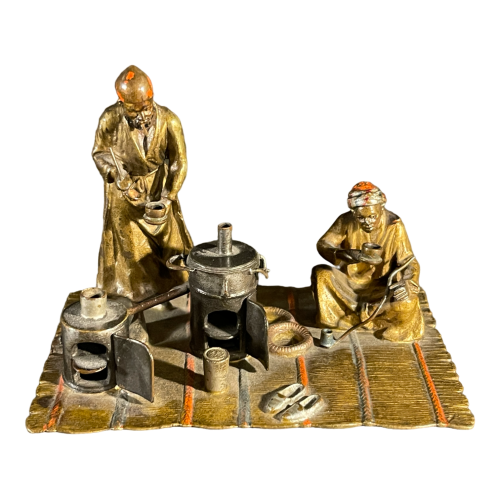Merchants, sellers or simply inhabitants in tea pose or ceremony, installed on an Orient carpet.
Antique and authentic piece (late 19th century).
Very good original condition, attributable to Franz Bergmann.
- Artist - Designer:Attributed to Franz Xaver Bergmann (1861-1936)
- Edition - Issuer:Bronze de Vienne
- Period:End of 19th century, ca 1890
- Country of Origin:Austria
- Dimensions (H x L x D):7cm x 10cm x 7 cm
- Weight:about 300 gr
- Condition:Excellent
- Material:Gilded & Polychromed Bronze
-
Price:SOLD
- Free international delivery
Reference book: "Bronzes of Vienna" Ernst Hrabalek
Franz Xaver Bergmann (1861-1936), owner of a Viennese foundry which produced numerous miniature sculptures and figures of orientalist, Arabist, erotic and animal forms with a bronze patina (humorous, whimsical, humanised art objects). He inherited the family business founded in 1860 and opened a new foundry in 1900. Many bronzes from the 1900s were still based on designs from his father's workshop. His workshops employed many anonymous sculptors on a temporary basis.
At the turn of the 19th century, there were about fifty similar workshops in Vienna producing 'Viennese bronzes'. Cold-painted bronze' refers to pieces that were cast and then decorated in several layers with so-called dust paint, usually made by women working at home.
The sensual poses of young women in the Art Nouveau or Oriental style were discreetly disguised by clothing or drapery which was revealed when a button was pushed or a lever moved.... Numerous animals such as musician signs, hares, bears, foxes, frogs..., made the reputation of these factories.
Other sculptors also worked in these workshops, including Ferdinand Preiss, Franz Josef Starek, Carl Kauba, Chotka, Mar Gub, some of whom bear the Argentor Vienna mark, and Bruno Zach, who asked Bergmann to edit and mould some of his works, including some erotic ones signed "Prof. Tuch", a pseudonym used by Zach.
Not to be confused with the Nuremberg lead sculptures, made of lead, of lesser quality and durability.
